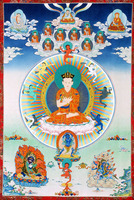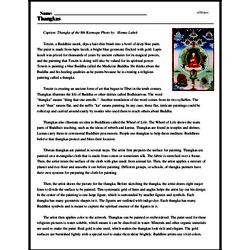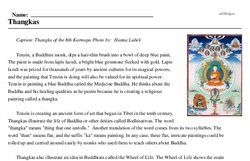Thangkas
Caption: Thangka of the 8th Karmapa Photo by: Hanna Lubek
Tenzin, a Buddhist monk, dips a hair-thin brush into a bowl of deep blue paint. The paint is made from lapis lazuli, a bright blue gemstone flecked with gold. Lapis lazuli was prized for thousands of years by ancient cultures for its magical powers, and the painting that Tenzin is doing will also be valued for its spiritual power. Tenzin is painting a blue Buddha called the Medicine Buddha. He thinks about the Buddha and his healing qualities as he paints because he is creating a religious painting called a thangka.
Tenzin is creating an ancient form of art that began in Tibet in the tenth century. Thangkas illustrate the life of Buddha or other deities called Bodhisattvas. The word "thangka" means "thing that one unrolls." Another translation of the word comes from its two syllables. The word "than" means flat, and the suffix "ka" means painting. In any case, these flat, intricate paintings could be rolled up and carried around easily by monks who used them to teach others about Buddha.
Thangkas also illustrate an idea in Buddhism called the Wheel of Life. The Wheel of Life shows the main parts of Buddha's teaching, such as the ideas of rebirth and karma. Thangkas are found in temples and shrines. Lamas carry them in ceremonial Buddhist processions. People use thangkas to help them meditate. Buddhists believe that thangkas protect and bless their location.
Tibetan thangkas are painted in several steps. The artist first prepares the surface for painting. Thangkas are painted on a rectangular cloth that is made from cotton or sometimes silk. The fabric is stretched over a frame. Then, the artist treats the surface of the cloth with glue made from animal fat. Then, the artist applies a mixture of plaster and rice flour and smooths it out before painting. Different groups, or schools, of thangka painters have their own systems for preparing the cloth for painting.




